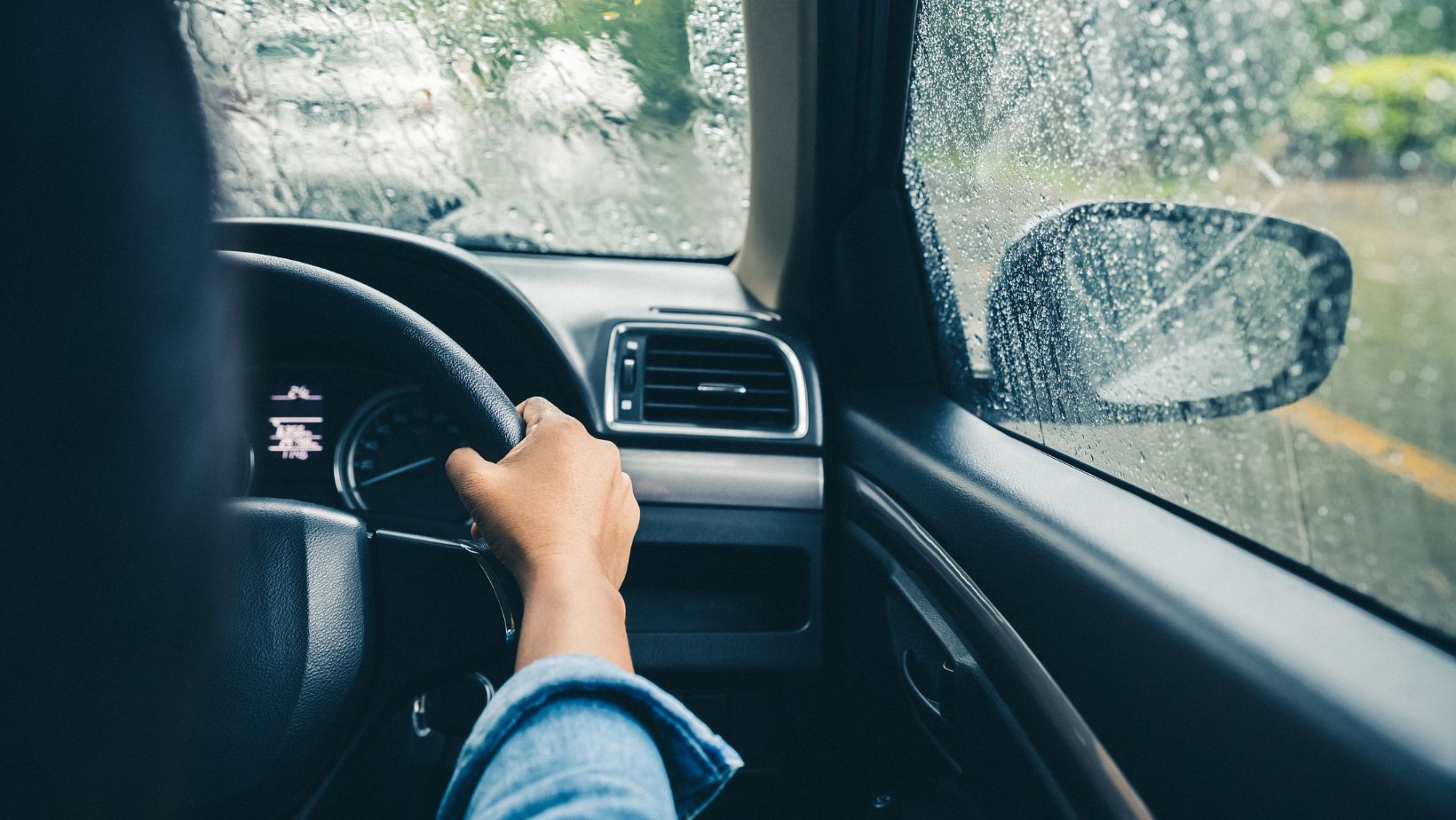
Whether you’re cruising through the busy streets of Grand Rapids or enjoying the scenic stretches along the Great Lakes, Michigan offers plenty of beautiful drives. While these roads are full of charm and character, Michigan’s weather can be anything but predictable.
You might be taking golden hour selfies one minute and find yourself caught in a downpour the next. This sudden weather shift can turn roads slick and treacherous, affecting your traction, braking performance, and overall control.
According to the U.S. Department of Transportation, wet pavement accounts for 70% of weather-related accidents, while nearly half (46%) happen during rainfall.
Since the National Weather Service has recently reported record-setting rainfall in multiple Michigan cities, including Detroit, Kalamazoo, Flint, Grand Rapids, Lansing, Muskegon, and Battle Creek, it has become even more important to service your vehicle and adjust your driving technique.
In this article, we’ll walk you through simple vehicle checks, tips for staying in control when roads get slick, and storm-smart driving habits for your rainy-day adventure.
What Makes Michigan’s Rainy Season Particularly Challenging?
When it rains in Michigan, the inclement weather and tricky road conditions make it particularly tough for the average driver to get anywhere without white-knuckling the wheel.
One of the biggest issues? During dry spells, oil, grease, and engine fluids build up on the pavement. The rain doesn’t wash it away but actually brings it to the surface, creating a slick surface similar to “black ice.” If you’ve ever hit a patch of black ice, you know the feeling: tires lose traction in an instant while steering becomes unresponsive, leaving you with little control over the vehicle. Rain-slicked roads can do the exact same thing.
Then there’s the water itself. Michigan’s full of lakes, streams, and ponds, which are beautiful — but after heavy rain, they often spill over onto the roads. These rain runoffs form surprise water pockets that hide potholes and shoulder washouts. On top of that, excessive rain can overwhelm drainage systems, raising the risk of flash flooding in low-lying areas or around clogged storm drains.
Hydroplaning is another major issue. It happens when your tires can’t channel water away fast enough, causing your car to skim across the water’s surface instead of gripping the road. At that point, steering and braking become borderline impossible until your tires regain contact with the pavement — which could take terrifying seconds that feel like forever.
Pre-Drive Vehicle Preparations for Rainy Conditions
 Before heading out in rainy weather, it’s important to go over the following checks, especially if you drive a wheelchair-accessible vehicle:
Before heading out in rainy weather, it’s important to go over the following checks, especially if you drive a wheelchair-accessible vehicle:
Inspect Tire Condition and Pressure
Tire tread depth plays a critical role in wet-road traction. Worn-out tires lose grip quickly on slick pavement, increasing the risk of skidding or hydroplaning. Ideally, your tire tread should be at least 2/32 of an inch. When confused, do a quick tread check by inserting a quarter into the tread with Washington’s head down. If you can see the top of his head, it’s time for new tires.
Wheelchair-accessible vehicles are usually heavier due to modifications, which can put extra stress on the tires. So it’s even more important to inspect them regularly. Don’t forget to check your tire pressure using a simple gauge. Make sure it falls between 28 and 36 PSI, depending on your vehicle.
Replace Worn Windshield Wipers and Clear the Glass
Visibility is everything in heavy rain. If your wiper blades leave streaks or squeak loudly, they’re past their prime and must be replaced. Clean windshields and mirrors regularly to prevent glare and smearing. Use your defoggers and air conditioning to clear fogged windows from the inside, improving visibility in humid or rainy weather.
Test All Exterior Lights and Electrical Components
Functioning headlights, taillights, brake lights, and hazard lights are vital for safe driving in low-visibility conditions. Confirm that all your bulbs are working and the lenses are clean. If you own a modified vehicle with extra electrical features like power ramps and lifts, ensure all the connections are dry and properly sealed.
Check Door Seals and Weatherstripping
Weatherstripping around vehicle doors should form a tight seal to prevent rainwater from entering. Damaged or worn seals can allow moisture inside, leading to potential damage to flooring, electronics, or mobility equipment. To test the seal, close the door on a sheet of paper or a dollar bill. If you can pull it out without resistance, your seal may need replacing.
Safe Driving Techniques During Michigan’s Rain
Between sudden showers, slick roads, and surprise puddles, it pays to be extra cautious behind the wheel. Follow these tips to stay in control when the weather isn’t:
- Wet pavement doesn’t give you the same grip as dry asphalt, so adjusting your driving speed is crucial. Slow down — not just by a few ticks, but enough to feel the difference. Maintain a safe following distance — about a car length per 10 mph — because wet roads extend your braking distance. Avoid sudden braking or accelerating to prevent your tires from losing traction. It’s also wise to disable cruise control as it can cause your vehicle to maintain speed on slick surfaces.
- Most people think hydroplaning only happens in torrential rainfall. However, only 1/12 of an inch of water and speeds over 35 mph can cause your tires to lose contact with the road. If it happens, ease off the gas, don’t brake, and steer gently until you regain control.
- Use your low-beam headlights even during light rain so others can see you. Signal early when merging or turning so others know your intentions.
- Scan the road ahead for large puddles or pooling water, as they can mask potholes or other hazardous objects. If you must drive through standing water, proceed slowly and steadily, ensuring the water level doesn’t rise above your vehicle’s bottom edge. Always remember, “Turn around, don’t drown.” It’s better to find an alternate route than to risk being swept away or stuck in a flood.
- Rushing through a storm is never worth the risk. So leave more space between vehicles around you while driving to reduce the risk of collision. Add at least a second or two to your following distance. This way, everyone will have enough time to react, according to the changing weather and traffic conditions.
Like What you're reading? Subscribe to our Newsletter and get new updates directly to your inbox
Specific Considerations for BraunAbility Wheelchair Accessible Vans
 While a BraunAbility wheelchair-accessible van performs similarly to a standard vehicle in the rain, there are specific considerations to keep in mind:
While a BraunAbility wheelchair-accessible van performs similarly to a standard vehicle in the rain, there are specific considerations to keep in mind:
Ground Clearance and Underbody Exposure
BraunAbility vans usually have lowered floors, which means water could penetrate the vehicle and potentially damage the ramp housing and kneeling mechanisms. Similarly, the undercarriage of your modified vehicle is more exposed to the elements than that of standard cars. This exposure can lead to damage from road spray and debris. To protect the exhaust system, ramp housing, and kneeling mechanism, drive slowly through large puddles, so the water doesn’t splash up.
Weight Distribution
Different modifications, like the lowered floor and ramp assembly, can slightly alter the vehicle’s weight distribution. If you’re transitioning from a standard car, give yourself extra time to adjust to the modified vehicle’s handling. Take turns more slowly, pay attention to acceleration and braking, and be mindful of the vehicle’s center of gravity when driving on slippery roads.
Electronics and Door Seals
While BraunAbility conversions are designed to protect sensitive components from water, you must inspect electrical connections for signs of wear or malfunction. During heavy rain, be cautious when opening and closing the side or rear-entry doors to prevent water from entering the vehicle.
Safe Loading and Unloading
When deploying the ramp during rainy weather, park in locations where water won’t gather around the ramp for safer entry and exit. After use, clear any mud or debris from the ramp hinges and tracks to maintain smooth operation.
Emergency Preparedness for Rainy Season Driving
When the weather takes a turn, the following plan will make all the difference between a minor inconvenience and a major breakdown:
- Prepare an emergency kit that contains a flashlight with extra batteries, a small tool kit, jumper cables, emergency flares, a portable phone charger, and a fully stocked first aid kit. Don’t forget non-perishable snacks and bottled water in case you’re stuck waiting for help.
- You don’t need to be glued to the news, but a quick check before hitting the road can save you hours. Download a reliable weather app and set up weather alerts for your area so you know when rain’s getting serious. Look for flood warnings, construction, or road closures — and map out a backup plan just in case.
- If your vehicle stalls or breaks down, signal early and pull over away from curves or heavy traffic. Turn on your hazard lights immediately or set up reflective triangles to make your vehicle more visible.
- Stay inside and call roadside assistance right away. Getting out on a wet roadside is risky, especially for those using mobility devices. If you’re driving a wheelchair-accessible vehicle, make sure your ramp, lift, and power system are secure and functioning before exiting, so you can transfer out easily.
Tips to Maintain Your Vehicle After Rainy Weather
Keep the following tips in mind to keep your wheelchair-accessible vehicle in tip-top condition:
- After driving in the rain, wash your vehicle to remove road salt, grime, and debris that can build up and cause long-term damage.
- Check the vehicle’s electrical components, especially under the hood and in the cabin, for signs of water damage. Moisture can short-circuit sensitive electronics, so it’s important to catch it early.
- Inspect the ramp mechanism after rainy weather to ensure it is functioning properly. Look for any signs of rust, sticking, or wear in the parts that can affect its operation. Clean and lubricate any moving parts to ensure the ramp opens and closes smoothly, reducing the risk of malfunction down the road.
Secure Your Ride with Clock Mobility
During the rainy season, you need to be extra cautious to stay safe on the road. At Clock Mobility, we offer different services, such as comprehensive vehicle inspections, specialized ramp maintenance, undercarriage inspections, tire checks, brake assessments, and weatherproofing solutions to keep your vehicle in top condition.
We also provide a range of rain-ready rental vehicles that are equipped to handle the challenges of wet weather, so you won’t have to worry about tire inspections or ramp maintenance. Besides vehicle rentals, we offer mobility solutions such as portable ramps and mobility scooters to make getting around easier and safer. Call us at (866) 380-3326 to get a rental quote, or visit one of our four Michigan locations to explore our services.
